Cunningham Holdings: Golf Resort Project Data Analysis & Report
VerifiedAdded on 2023/03/29
|13
|2772
|339
Case Study
AI Summary
This case study presents a data analysis and decision modeling exercise for Cunningham Holdings, a family-owned firm planning to construct an international golf resort. The core issue revolves around selecting the optimal clubhouse type to maximize consumer enjoyment while staying within a $20 million budget. Six models were developed, including a standard model, an exclusive model (which proved infeasible), and several alternative options with varying enjoyment indices and construction costs. The analysis evaluates the feasibility and implications of each model, considering factors like land usage, golf hole configurations, and the type of clubhouse. The report recommends that the managers implement the model derived by option 1, which balances enjoyment and cost-effectiveness. This case study highlights the complexities of balancing stakeholder preferences with financial constraints in large-scale hospitality projects. Desklib provides a wealth of similar solved assignments and resources for students.
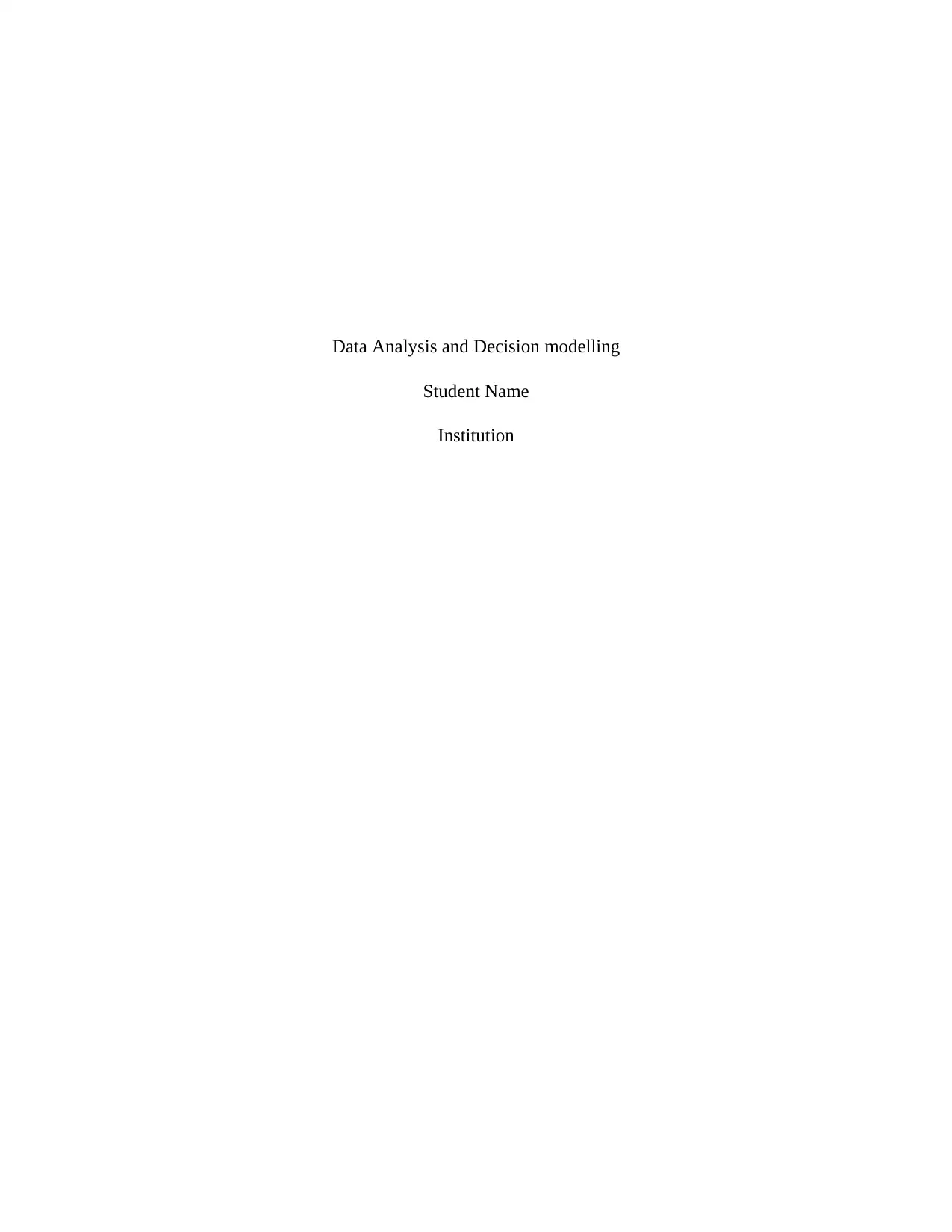
Data Analysis and Decision modelling
Student Name
Institution
Student Name
Institution
Paraphrase This Document
Need a fresh take? Get an instant paraphrase of this document with our AI Paraphraser
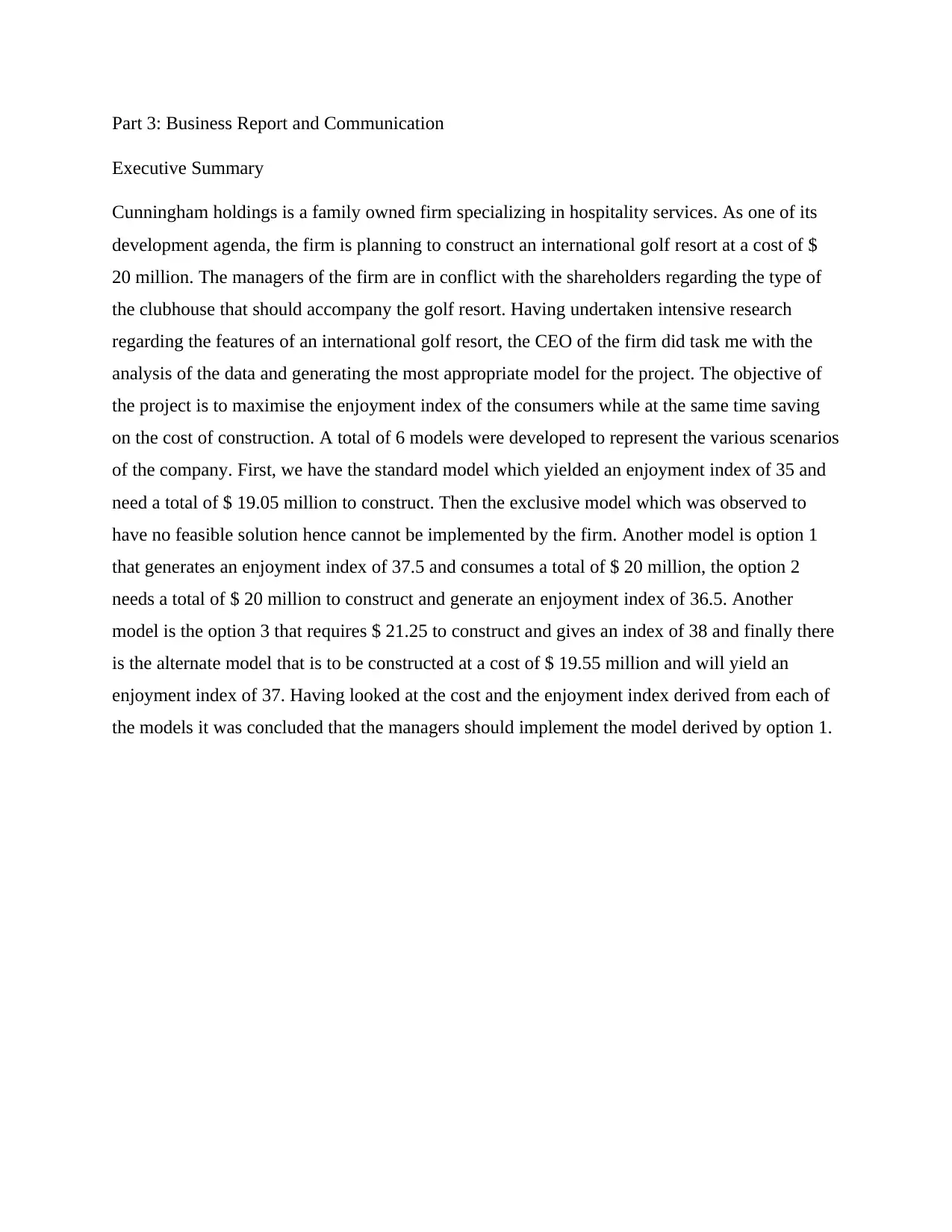
Part 3: Business Report and Communication
Executive Summary
Cunningham holdings is a family owned firm specializing in hospitality services. As one of its
development agenda, the firm is planning to construct an international golf resort at a cost of $
20 million. The managers of the firm are in conflict with the shareholders regarding the type of
the clubhouse that should accompany the golf resort. Having undertaken intensive research
regarding the features of an international golf resort, the CEO of the firm did task me with the
analysis of the data and generating the most appropriate model for the project. The objective of
the project is to maximise the enjoyment index of the consumers while at the same time saving
on the cost of construction. A total of 6 models were developed to represent the various scenarios
of the company. First, we have the standard model which yielded an enjoyment index of 35 and
need a total of $ 19.05 million to construct. Then the exclusive model which was observed to
have no feasible solution hence cannot be implemented by the firm. Another model is option 1
that generates an enjoyment index of 37.5 and consumes a total of $ 20 million, the option 2
needs a total of $ 20 million to construct and generate an enjoyment index of 36.5. Another
model is the option 3 that requires $ 21.25 to construct and gives an index of 38 and finally there
is the alternate model that is to be constructed at a cost of $ 19.55 million and will yield an
enjoyment index of 37. Having looked at the cost and the enjoyment index derived from each of
the models it was concluded that the managers should implement the model derived by option 1.
Executive Summary
Cunningham holdings is a family owned firm specializing in hospitality services. As one of its
development agenda, the firm is planning to construct an international golf resort at a cost of $
20 million. The managers of the firm are in conflict with the shareholders regarding the type of
the clubhouse that should accompany the golf resort. Having undertaken intensive research
regarding the features of an international golf resort, the CEO of the firm did task me with the
analysis of the data and generating the most appropriate model for the project. The objective of
the project is to maximise the enjoyment index of the consumers while at the same time saving
on the cost of construction. A total of 6 models were developed to represent the various scenarios
of the company. First, we have the standard model which yielded an enjoyment index of 35 and
need a total of $ 19.05 million to construct. Then the exclusive model which was observed to
have no feasible solution hence cannot be implemented by the firm. Another model is option 1
that generates an enjoyment index of 37.5 and consumes a total of $ 20 million, the option 2
needs a total of $ 20 million to construct and generate an enjoyment index of 36.5. Another
model is the option 3 that requires $ 21.25 to construct and gives an index of 38 and finally there
is the alternate model that is to be constructed at a cost of $ 19.55 million and will yield an
enjoyment index of 37. Having looked at the cost and the enjoyment index derived from each of
the models it was concluded that the managers should implement the model derived by option 1.
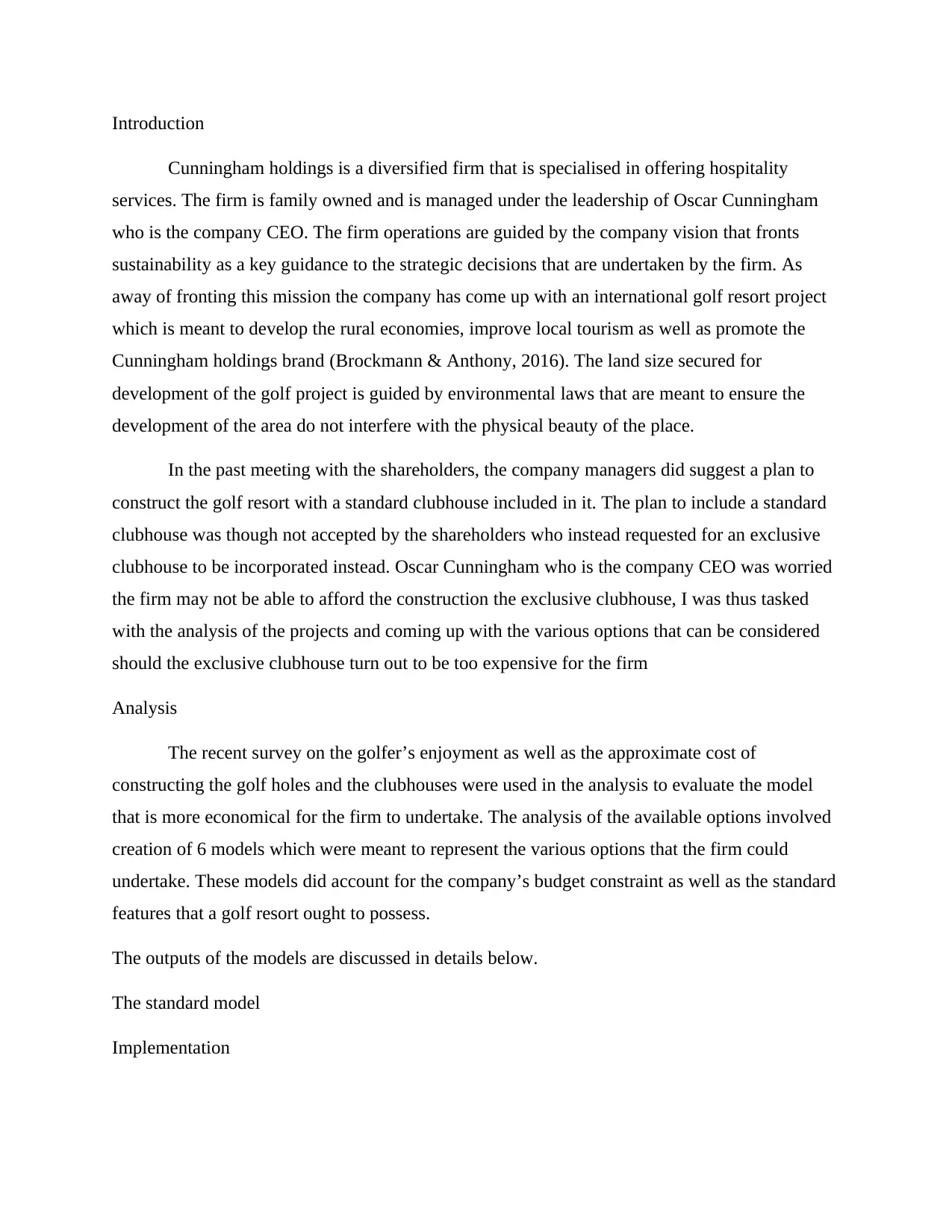
Introduction
Cunningham holdings is a diversified firm that is specialised in offering hospitality
services. The firm is family owned and is managed under the leadership of Oscar Cunningham
who is the company CEO. The firm operations are guided by the company vision that fronts
sustainability as a key guidance to the strategic decisions that are undertaken by the firm. As
away of fronting this mission the company has come up with an international golf resort project
which is meant to develop the rural economies, improve local tourism as well as promote the
Cunningham holdings brand (Brockmann & Anthony, 2016). The land size secured for
development of the golf project is guided by environmental laws that are meant to ensure the
development of the area do not interfere with the physical beauty of the place.
In the past meeting with the shareholders, the company managers did suggest a plan to
construct the golf resort with a standard clubhouse included in it. The plan to include a standard
clubhouse was though not accepted by the shareholders who instead requested for an exclusive
clubhouse to be incorporated instead. Oscar Cunningham who is the company CEO was worried
the firm may not be able to afford the construction the exclusive clubhouse, I was thus tasked
with the analysis of the projects and coming up with the various options that can be considered
should the exclusive clubhouse turn out to be too expensive for the firm
Analysis
The recent survey on the golfer’s enjoyment as well as the approximate cost of
constructing the golf holes and the clubhouses were used in the analysis to evaluate the model
that is more economical for the firm to undertake. The analysis of the available options involved
creation of 6 models which were meant to represent the various options that the firm could
undertake. These models did account for the company’s budget constraint as well as the standard
features that a golf resort ought to possess.
The outputs of the models are discussed in details below.
The standard model
Implementation
Cunningham holdings is a diversified firm that is specialised in offering hospitality
services. The firm is family owned and is managed under the leadership of Oscar Cunningham
who is the company CEO. The firm operations are guided by the company vision that fronts
sustainability as a key guidance to the strategic decisions that are undertaken by the firm. As
away of fronting this mission the company has come up with an international golf resort project
which is meant to develop the rural economies, improve local tourism as well as promote the
Cunningham holdings brand (Brockmann & Anthony, 2016). The land size secured for
development of the golf project is guided by environmental laws that are meant to ensure the
development of the area do not interfere with the physical beauty of the place.
In the past meeting with the shareholders, the company managers did suggest a plan to
construct the golf resort with a standard clubhouse included in it. The plan to include a standard
clubhouse was though not accepted by the shareholders who instead requested for an exclusive
clubhouse to be incorporated instead. Oscar Cunningham who is the company CEO was worried
the firm may not be able to afford the construction the exclusive clubhouse, I was thus tasked
with the analysis of the projects and coming up with the various options that can be considered
should the exclusive clubhouse turn out to be too expensive for the firm
Analysis
The recent survey on the golfer’s enjoyment as well as the approximate cost of
constructing the golf holes and the clubhouses were used in the analysis to evaluate the model
that is more economical for the firm to undertake. The analysis of the available options involved
creation of 6 models which were meant to represent the various options that the firm could
undertake. These models did account for the company’s budget constraint as well as the standard
features that a golf resort ought to possess.
The outputs of the models are discussed in details below.
The standard model
Implementation
⊘ This is a preview!⊘
Do you want full access?
Subscribe today to unlock all pages.

Trusted by 1+ million students worldwide
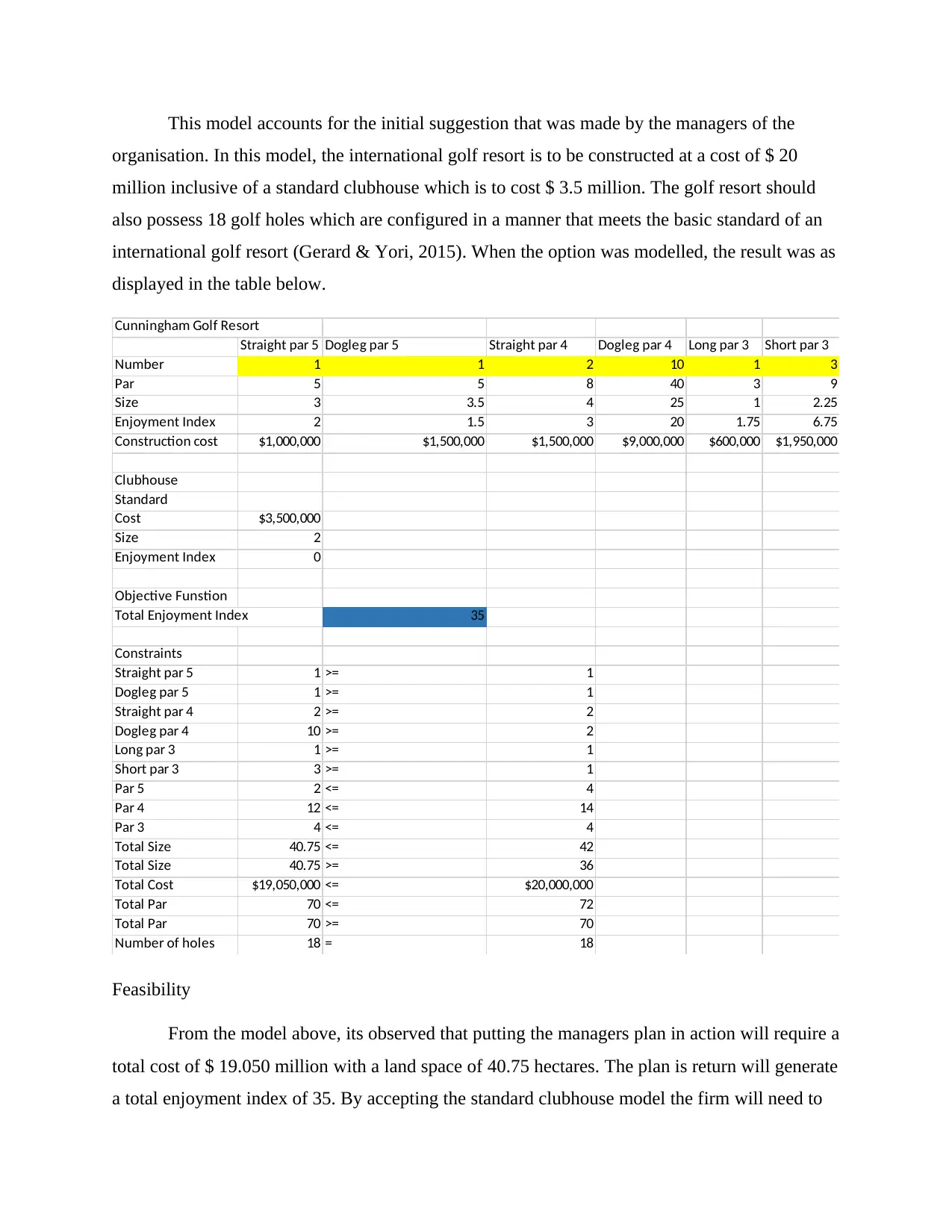
This model accounts for the initial suggestion that was made by the managers of the
organisation. In this model, the international golf resort is to be constructed at a cost of $ 20
million inclusive of a standard clubhouse which is to cost $ 3.5 million. The golf resort should
also possess 18 golf holes which are configured in a manner that meets the basic standard of an
international golf resort (Gerard & Yori, 2015). When the option was modelled, the result was as
displayed in the table below.
Cunningham Golf Resort
Straight par 5 Dogleg par 5 Straight par 4 Dogleg par 4 Long par 3 Short par 3
Number 1 1 2 10 1 3
Par 5 5 8 40 3 9
Size 3 3.5 4 25 1 2.25
Enjoyment Index 2 1.5 3 20 1.75 6.75
Construction cost $1,000,000 $1,500,000 $1,500,000 $9,000,000 $600,000 $1,950,000
Clubhouse
Standard
Cost $3,500,000
Size 2
Enjoyment Index 0
Objective Funstion
Total Enjoyment Index 35
Constraints
Straight par 5 1 >= 1
Dogleg par 5 1 >= 1
Straight par 4 2 >= 2
Dogleg par 4 10 >= 2
Long par 3 1 >= 1
Short par 3 3 >= 1
Par 5 2 <= 4
Par 4 12 <= 14
Par 3 4 <= 4
Total Size 40.75 <= 42
Total Size 40.75 >= 36
Total Cost $19,050,000 <= $20,000,000
Total Par 70 <= 72
Total Par 70 >= 70
Number of holes 18 = 18
Feasibility
From the model above, its observed that putting the managers plan in action will require a
total cost of $ 19.050 million with a land space of 40.75 hectares. The plan is return will generate
a total enjoyment index of 35. By accepting the standard clubhouse model the firm will need to
organisation. In this model, the international golf resort is to be constructed at a cost of $ 20
million inclusive of a standard clubhouse which is to cost $ 3.5 million. The golf resort should
also possess 18 golf holes which are configured in a manner that meets the basic standard of an
international golf resort (Gerard & Yori, 2015). When the option was modelled, the result was as
displayed in the table below.
Cunningham Golf Resort
Straight par 5 Dogleg par 5 Straight par 4 Dogleg par 4 Long par 3 Short par 3
Number 1 1 2 10 1 3
Par 5 5 8 40 3 9
Size 3 3.5 4 25 1 2.25
Enjoyment Index 2 1.5 3 20 1.75 6.75
Construction cost $1,000,000 $1,500,000 $1,500,000 $9,000,000 $600,000 $1,950,000
Clubhouse
Standard
Cost $3,500,000
Size 2
Enjoyment Index 0
Objective Funstion
Total Enjoyment Index 35
Constraints
Straight par 5 1 >= 1
Dogleg par 5 1 >= 1
Straight par 4 2 >= 2
Dogleg par 4 10 >= 2
Long par 3 1 >= 1
Short par 3 3 >= 1
Par 5 2 <= 4
Par 4 12 <= 14
Par 3 4 <= 4
Total Size 40.75 <= 42
Total Size 40.75 >= 36
Total Cost $19,050,000 <= $20,000,000
Total Par 70 <= 72
Total Par 70 >= 70
Number of holes 18 = 18
Feasibility
From the model above, its observed that putting the managers plan in action will require a
total cost of $ 19.050 million with a land space of 40.75 hectares. The plan is return will generate
a total enjoyment index of 35. By accepting the standard clubhouse model the firm will need to
Paraphrase This Document
Need a fresh take? Get an instant paraphrase of this document with our AI Paraphraser
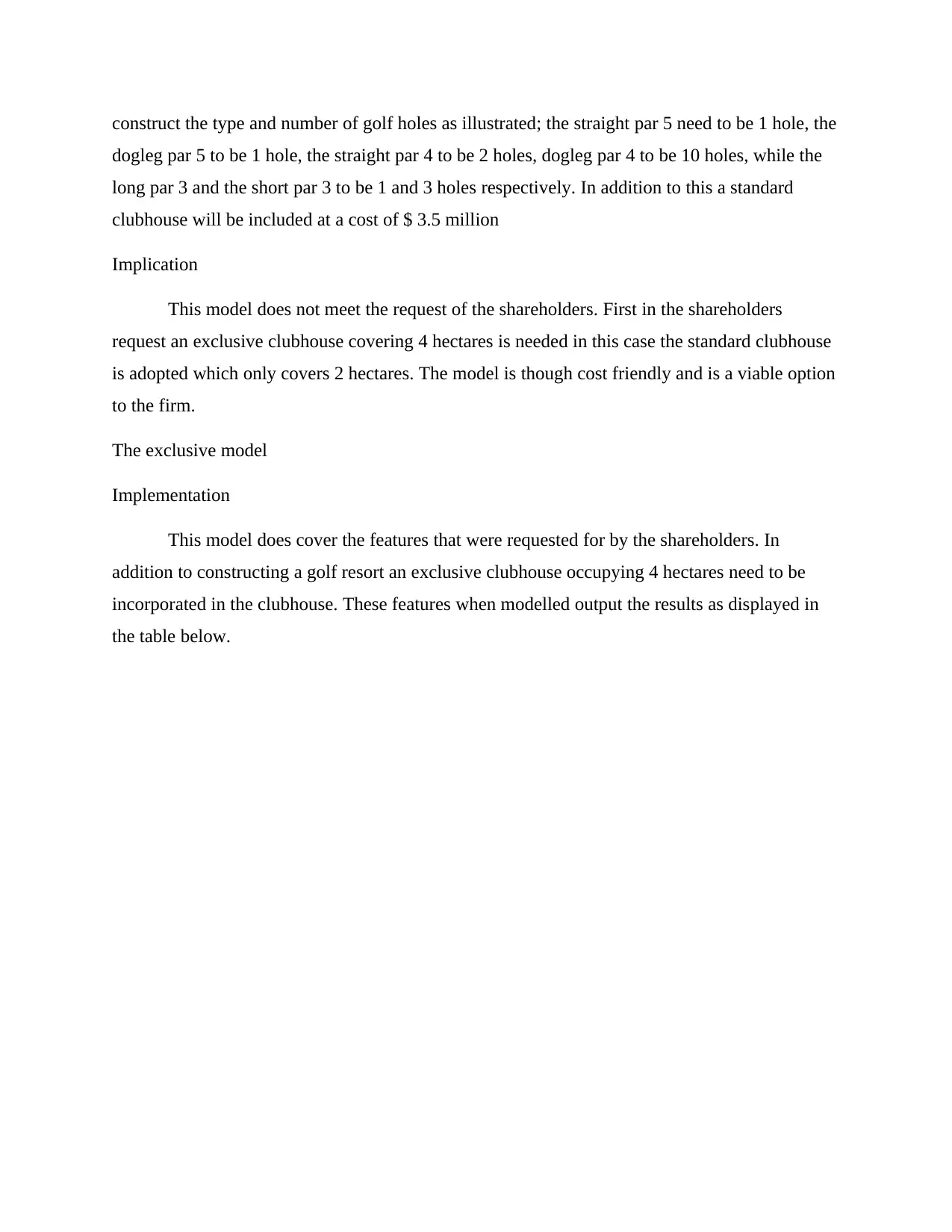
construct the type and number of golf holes as illustrated; the straight par 5 need to be 1 hole, the
dogleg par 5 to be 1 hole, the straight par 4 to be 2 holes, dogleg par 4 to be 10 holes, while the
long par 3 and the short par 3 to be 1 and 3 holes respectively. In addition to this a standard
clubhouse will be included at a cost of $ 3.5 million
Implication
This model does not meet the request of the shareholders. First in the shareholders
request an exclusive clubhouse covering 4 hectares is needed in this case the standard clubhouse
is adopted which only covers 2 hectares. The model is though cost friendly and is a viable option
to the firm.
The exclusive model
Implementation
This model does cover the features that were requested for by the shareholders. In
addition to constructing a golf resort an exclusive clubhouse occupying 4 hectares need to be
incorporated in the clubhouse. These features when modelled output the results as displayed in
the table below.
dogleg par 5 to be 1 hole, the straight par 4 to be 2 holes, dogleg par 4 to be 10 holes, while the
long par 3 and the short par 3 to be 1 and 3 holes respectively. In addition to this a standard
clubhouse will be included at a cost of $ 3.5 million
Implication
This model does not meet the request of the shareholders. First in the shareholders
request an exclusive clubhouse covering 4 hectares is needed in this case the standard clubhouse
is adopted which only covers 2 hectares. The model is though cost friendly and is a viable option
to the firm.
The exclusive model
Implementation
This model does cover the features that were requested for by the shareholders. In
addition to constructing a golf resort an exclusive clubhouse occupying 4 hectares need to be
incorporated in the clubhouse. These features when modelled output the results as displayed in
the table below.
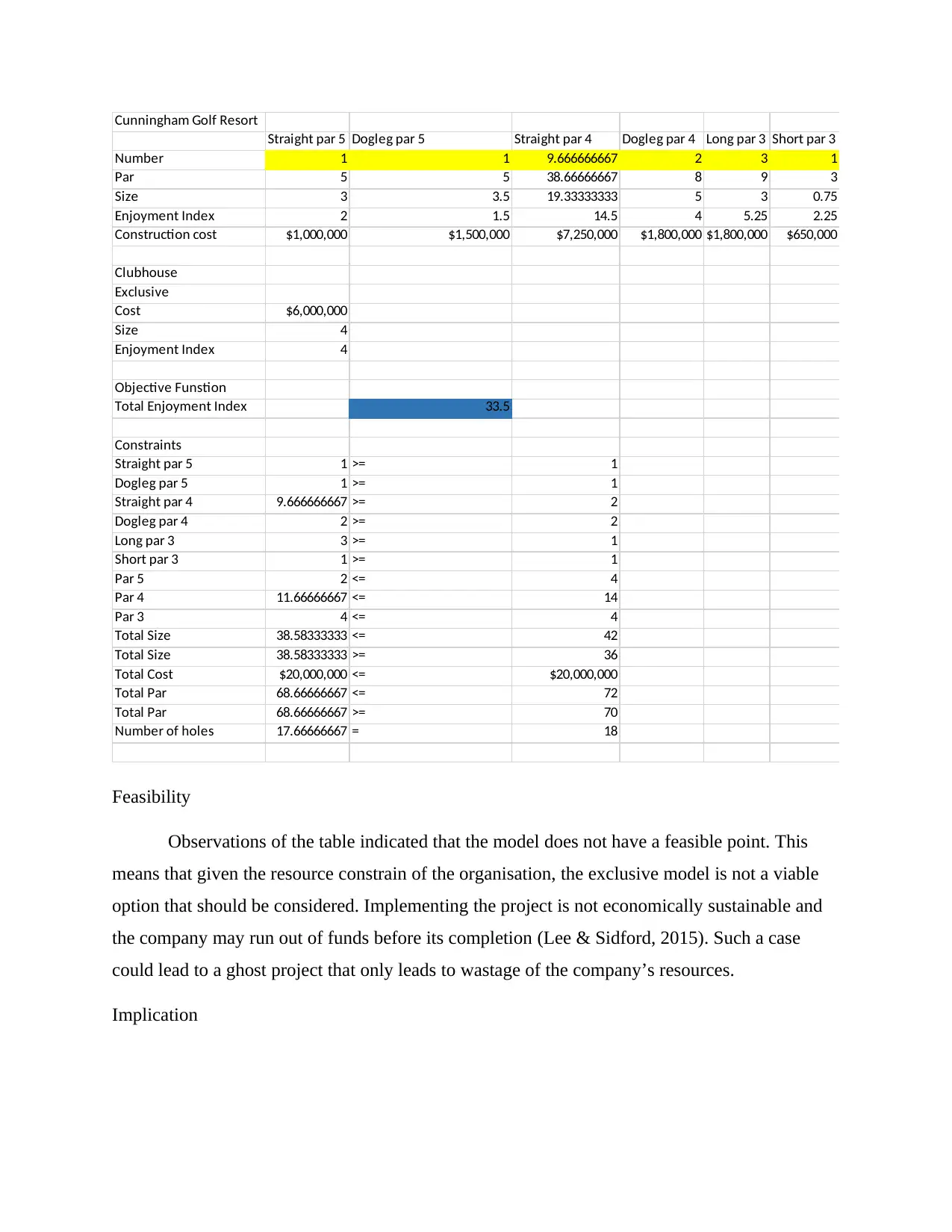
Cunningham Golf Resort
Straight par 5 Dogleg par 5 Straight par 4 Dogleg par 4 Long par 3 Short par 3
Number 1 1 9.666666667 2 3 1
Par 5 5 38.66666667 8 9 3
Size 3 3.5 19.33333333 5 3 0.75
Enjoyment Index 2 1.5 14.5 4 5.25 2.25
Construction cost $1,000,000 $1,500,000 $7,250,000 $1,800,000 $1,800,000 $650,000
Clubhouse
Exclusive
Cost $6,000,000
Size 4
Enjoyment Index 4
Objective Funstion
Total Enjoyment Index 33.5
Constraints
Straight par 5 1 >= 1
Dogleg par 5 1 >= 1
Straight par 4 9.666666667 >= 2
Dogleg par 4 2 >= 2
Long par 3 3 >= 1
Short par 3 1 >= 1
Par 5 2 <= 4
Par 4 11.66666667 <= 14
Par 3 4 <= 4
Total Size 38.58333333 <= 42
Total Size 38.58333333 >= 36
Total Cost $20,000,000 <= $20,000,000
Total Par 68.66666667 <= 72
Total Par 68.66666667 >= 70
Number of holes 17.66666667 = 18
Feasibility
Observations of the table indicated that the model does not have a feasible point. This
means that given the resource constrain of the organisation, the exclusive model is not a viable
option that should be considered. Implementing the project is not economically sustainable and
the company may run out of funds before its completion (Lee & Sidford, 2015). Such a case
could lead to a ghost project that only leads to wastage of the company’s resources.
Implication
Straight par 5 Dogleg par 5 Straight par 4 Dogleg par 4 Long par 3 Short par 3
Number 1 1 9.666666667 2 3 1
Par 5 5 38.66666667 8 9 3
Size 3 3.5 19.33333333 5 3 0.75
Enjoyment Index 2 1.5 14.5 4 5.25 2.25
Construction cost $1,000,000 $1,500,000 $7,250,000 $1,800,000 $1,800,000 $650,000
Clubhouse
Exclusive
Cost $6,000,000
Size 4
Enjoyment Index 4
Objective Funstion
Total Enjoyment Index 33.5
Constraints
Straight par 5 1 >= 1
Dogleg par 5 1 >= 1
Straight par 4 9.666666667 >= 2
Dogleg par 4 2 >= 2
Long par 3 3 >= 1
Short par 3 1 >= 1
Par 5 2 <= 4
Par 4 11.66666667 <= 14
Par 3 4 <= 4
Total Size 38.58333333 <= 42
Total Size 38.58333333 >= 36
Total Cost $20,000,000 <= $20,000,000
Total Par 68.66666667 <= 72
Total Par 68.66666667 >= 70
Number of holes 17.66666667 = 18
Feasibility
Observations of the table indicated that the model does not have a feasible point. This
means that given the resource constrain of the organisation, the exclusive model is not a viable
option that should be considered. Implementing the project is not economically sustainable and
the company may run out of funds before its completion (Lee & Sidford, 2015). Such a case
could lead to a ghost project that only leads to wastage of the company’s resources.
Implication
⊘ This is a preview!⊘
Do you want full access?
Subscribe today to unlock all pages.

Trusted by 1+ million students worldwide
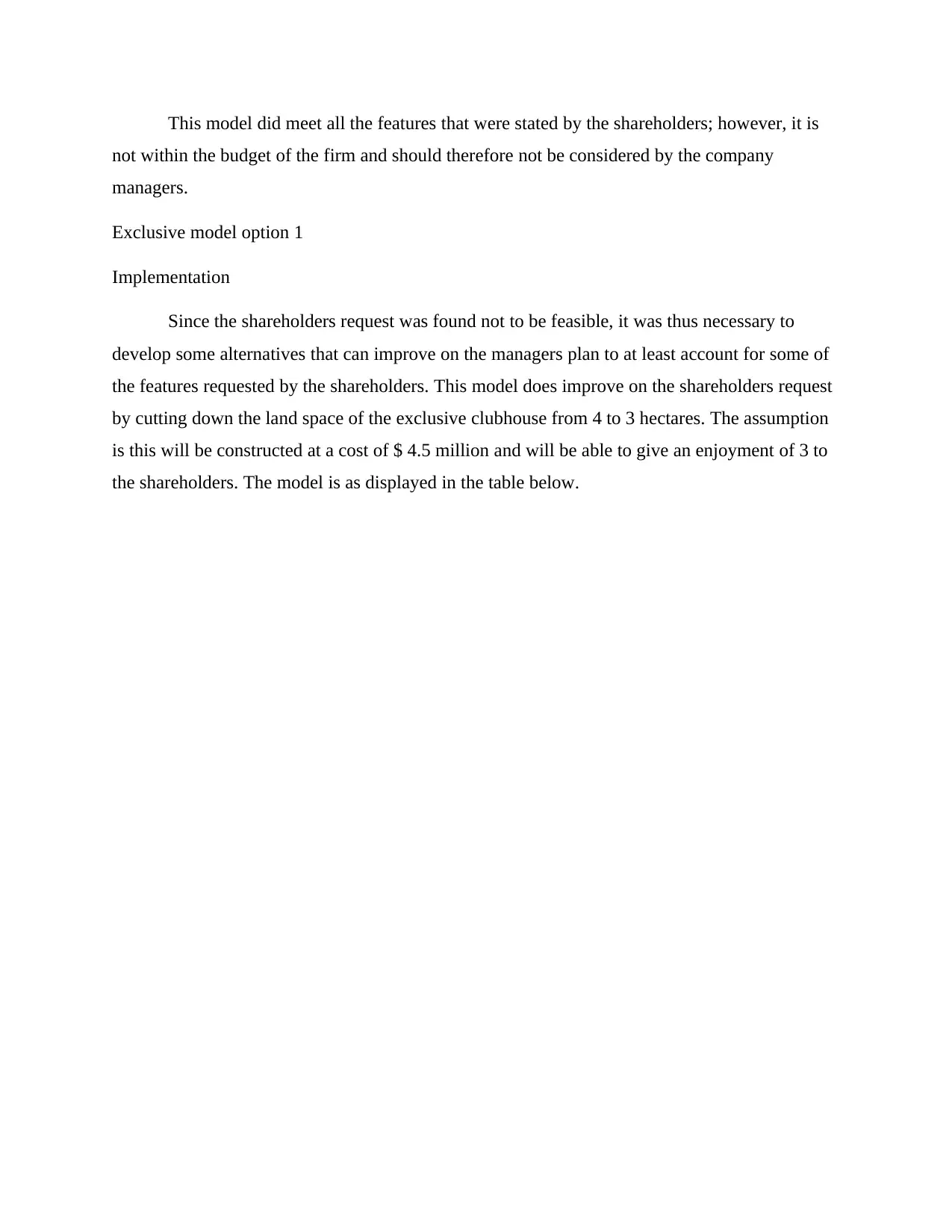
This model did meet all the features that were stated by the shareholders; however, it is
not within the budget of the firm and should therefore not be considered by the company
managers.
Exclusive model option 1
Implementation
Since the shareholders request was found not to be feasible, it was thus necessary to
develop some alternatives that can improve on the managers plan to at least account for some of
the features requested by the shareholders. This model does improve on the shareholders request
by cutting down the land space of the exclusive clubhouse from 4 to 3 hectares. The assumption
is this will be constructed at a cost of $ 4.5 million and will be able to give an enjoyment of 3 to
the shareholders. The model is as displayed in the table below.
not within the budget of the firm and should therefore not be considered by the company
managers.
Exclusive model option 1
Implementation
Since the shareholders request was found not to be feasible, it was thus necessary to
develop some alternatives that can improve on the managers plan to at least account for some of
the features requested by the shareholders. This model does improve on the shareholders request
by cutting down the land space of the exclusive clubhouse from 4 to 3 hectares. The assumption
is this will be constructed at a cost of $ 4.5 million and will be able to give an enjoyment of 3 to
the shareholders. The model is as displayed in the table below.
Paraphrase This Document
Need a fresh take? Get an instant paraphrase of this document with our AI Paraphraser
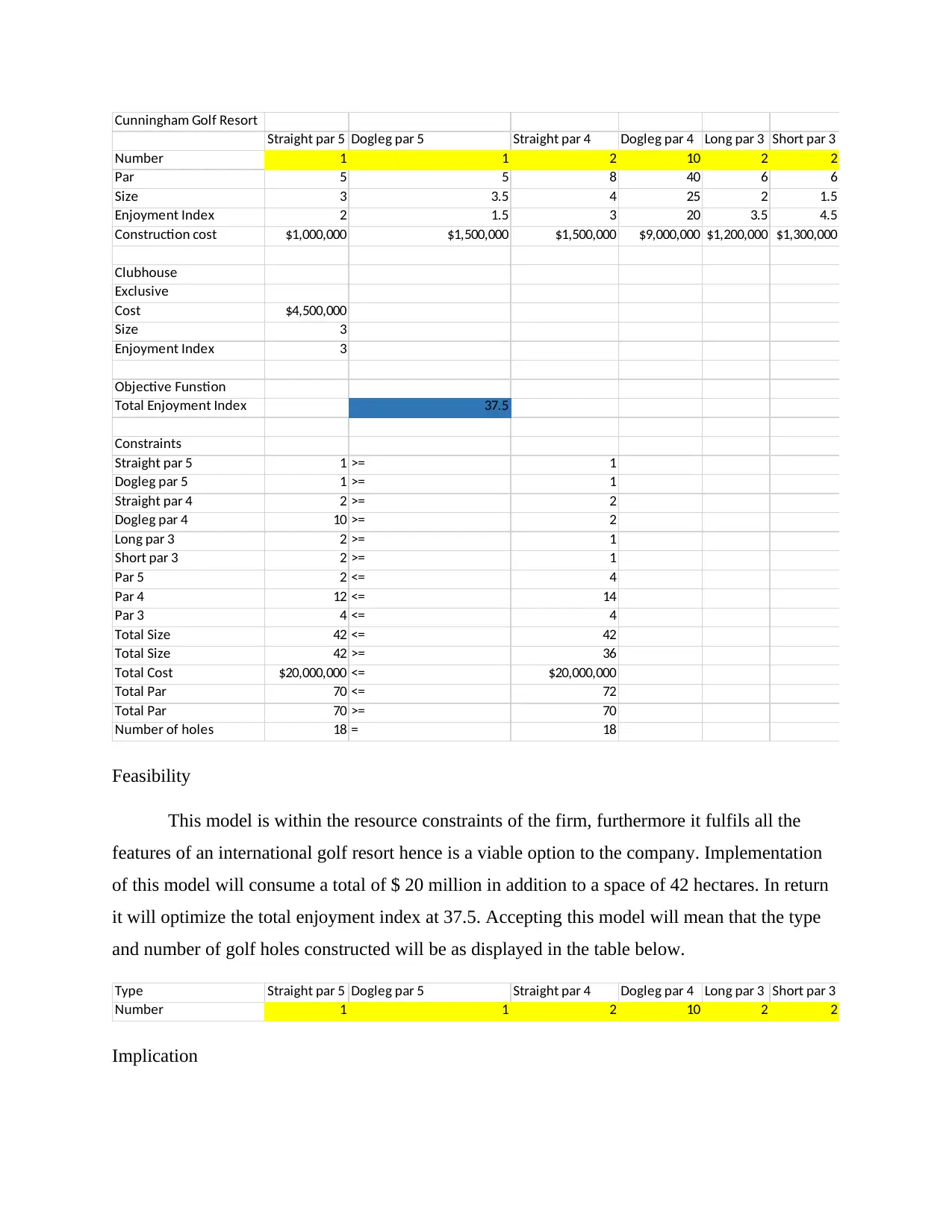
Cunningham Golf Resort
Straight par 5 Dogleg par 5 Straight par 4 Dogleg par 4 Long par 3 Short par 3
Number 1 1 2 10 2 2
Par 5 5 8 40 6 6
Size 3 3.5 4 25 2 1.5
Enjoyment Index 2 1.5 3 20 3.5 4.5
Construction cost $1,000,000 $1,500,000 $1,500,000 $9,000,000 $1,200,000 $1,300,000
Clubhouse
Exclusive
Cost $4,500,000
Size 3
Enjoyment Index 3
Objective Funstion
Total Enjoyment Index 37.5
Constraints
Straight par 5 1 >= 1
Dogleg par 5 1 >= 1
Straight par 4 2 >= 2
Dogleg par 4 10 >= 2
Long par 3 2 >= 1
Short par 3 2 >= 1
Par 5 2 <= 4
Par 4 12 <= 14
Par 3 4 <= 4
Total Size 42 <= 42
Total Size 42 >= 36
Total Cost $20,000,000 <= $20,000,000
Total Par 70 <= 72
Total Par 70 >= 70
Number of holes 18 = 18
Feasibility
This model is within the resource constraints of the firm, furthermore it fulfils all the
features of an international golf resort hence is a viable option to the company. Implementation
of this model will consume a total of $ 20 million in addition to a space of 42 hectares. In return
it will optimize the total enjoyment index at 37.5. Accepting this model will mean that the type
and number of golf holes constructed will be as displayed in the table below.
Type Straight par 5 Dogleg par 5 Straight par 4 Dogleg par 4 Long par 3 Short par 3
Number 1 1 2 10 2 2
Implication
Straight par 5 Dogleg par 5 Straight par 4 Dogleg par 4 Long par 3 Short par 3
Number 1 1 2 10 2 2
Par 5 5 8 40 6 6
Size 3 3.5 4 25 2 1.5
Enjoyment Index 2 1.5 3 20 3.5 4.5
Construction cost $1,000,000 $1,500,000 $1,500,000 $9,000,000 $1,200,000 $1,300,000
Clubhouse
Exclusive
Cost $4,500,000
Size 3
Enjoyment Index 3
Objective Funstion
Total Enjoyment Index 37.5
Constraints
Straight par 5 1 >= 1
Dogleg par 5 1 >= 1
Straight par 4 2 >= 2
Dogleg par 4 10 >= 2
Long par 3 2 >= 1
Short par 3 2 >= 1
Par 5 2 <= 4
Par 4 12 <= 14
Par 3 4 <= 4
Total Size 42 <= 42
Total Size 42 >= 36
Total Cost $20,000,000 <= $20,000,000
Total Par 70 <= 72
Total Par 70 >= 70
Number of holes 18 = 18
Feasibility
This model is within the resource constraints of the firm, furthermore it fulfils all the
features of an international golf resort hence is a viable option to the company. Implementation
of this model will consume a total of $ 20 million in addition to a space of 42 hectares. In return
it will optimize the total enjoyment index at 37.5. Accepting this model will mean that the type
and number of golf holes constructed will be as displayed in the table below.
Type Straight par 5 Dogleg par 5 Straight par 4 Dogleg par 4 Long par 3 Short par 3
Number 1 1 2 10 2 2
Implication
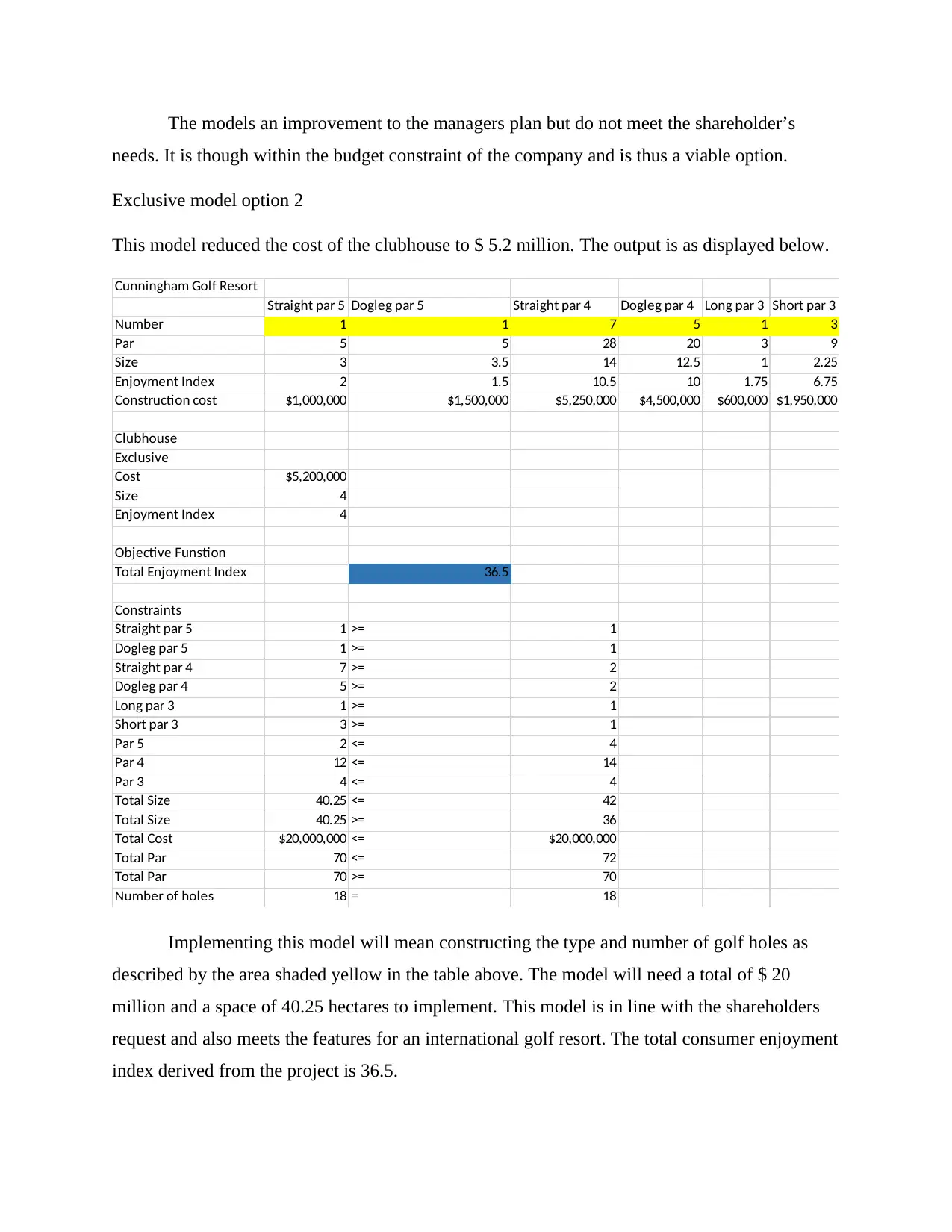
The models an improvement to the managers plan but do not meet the shareholder’s
needs. It is though within the budget constraint of the company and is thus a viable option.
Exclusive model option 2
This model reduced the cost of the clubhouse to $ 5.2 million. The output is as displayed below.
Cunningham Golf Resort
Straight par 5 Dogleg par 5 Straight par 4 Dogleg par 4 Long par 3 Short par 3
Number 1 1 7 5 1 3
Par 5 5 28 20 3 9
Size 3 3.5 14 12.5 1 2.25
Enjoyment Index 2 1.5 10.5 10 1.75 6.75
Construction cost $1,000,000 $1,500,000 $5,250,000 $4,500,000 $600,000 $1,950,000
Clubhouse
Exclusive
Cost $5,200,000
Size 4
Enjoyment Index 4
Objective Funstion
Total Enjoyment Index 36.5
Constraints
Straight par 5 1 >= 1
Dogleg par 5 1 >= 1
Straight par 4 7 >= 2
Dogleg par 4 5 >= 2
Long par 3 1 >= 1
Short par 3 3 >= 1
Par 5 2 <= 4
Par 4 12 <= 14
Par 3 4 <= 4
Total Size 40.25 <= 42
Total Size 40.25 >= 36
Total Cost $20,000,000 <= $20,000,000
Total Par 70 <= 72
Total Par 70 >= 70
Number of holes 18 = 18
Implementing this model will mean constructing the type and number of golf holes as
described by the area shaded yellow in the table above. The model will need a total of $ 20
million and a space of 40.25 hectares to implement. This model is in line with the shareholders
request and also meets the features for an international golf resort. The total consumer enjoyment
index derived from the project is 36.5.
needs. It is though within the budget constraint of the company and is thus a viable option.
Exclusive model option 2
This model reduced the cost of the clubhouse to $ 5.2 million. The output is as displayed below.
Cunningham Golf Resort
Straight par 5 Dogleg par 5 Straight par 4 Dogleg par 4 Long par 3 Short par 3
Number 1 1 7 5 1 3
Par 5 5 28 20 3 9
Size 3 3.5 14 12.5 1 2.25
Enjoyment Index 2 1.5 10.5 10 1.75 6.75
Construction cost $1,000,000 $1,500,000 $5,250,000 $4,500,000 $600,000 $1,950,000
Clubhouse
Exclusive
Cost $5,200,000
Size 4
Enjoyment Index 4
Objective Funstion
Total Enjoyment Index 36.5
Constraints
Straight par 5 1 >= 1
Dogleg par 5 1 >= 1
Straight par 4 7 >= 2
Dogleg par 4 5 >= 2
Long par 3 1 >= 1
Short par 3 3 >= 1
Par 5 2 <= 4
Par 4 12 <= 14
Par 3 4 <= 4
Total Size 40.25 <= 42
Total Size 40.25 >= 36
Total Cost $20,000,000 <= $20,000,000
Total Par 70 <= 72
Total Par 70 >= 70
Number of holes 18 = 18
Implementing this model will mean constructing the type and number of golf holes as
described by the area shaded yellow in the table above. The model will need a total of $ 20
million and a space of 40.25 hectares to implement. This model is in line with the shareholders
request and also meets the features for an international golf resort. The total consumer enjoyment
index derived from the project is 36.5.
⊘ This is a preview!⊘
Do you want full access?
Subscribe today to unlock all pages.

Trusted by 1+ million students worldwide
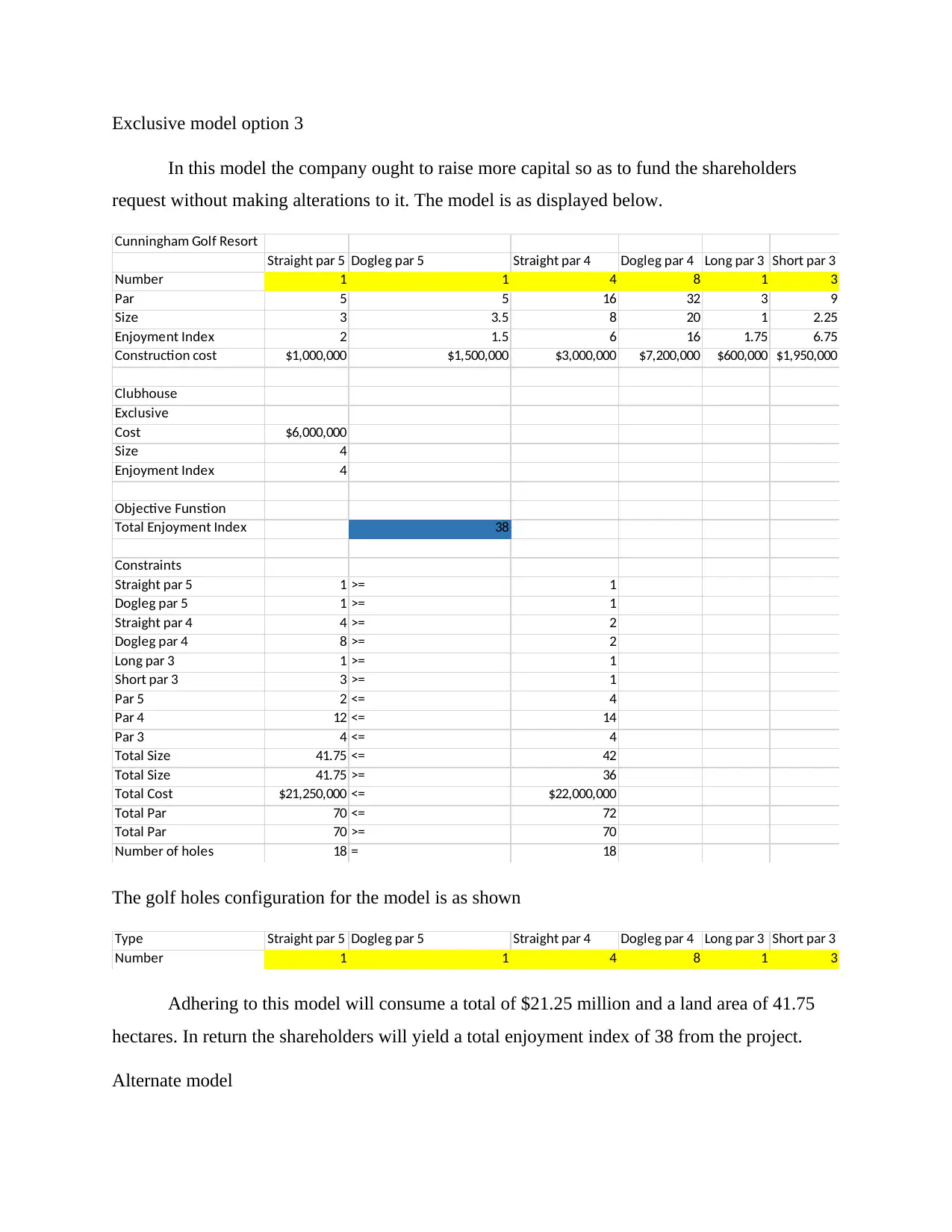
Exclusive model option 3
In this model the company ought to raise more capital so as to fund the shareholders
request without making alterations to it. The model is as displayed below.
Cunningham Golf Resort
Straight par 5 Dogleg par 5 Straight par 4 Dogleg par 4 Long par 3 Short par 3
Number 1 1 4 8 1 3
Par 5 5 16 32 3 9
Size 3 3.5 8 20 1 2.25
Enjoyment Index 2 1.5 6 16 1.75 6.75
Construction cost $1,000,000 $1,500,000 $3,000,000 $7,200,000 $600,000 $1,950,000
Clubhouse
Exclusive
Cost $6,000,000
Size 4
Enjoyment Index 4
Objective Funstion
Total Enjoyment Index 38
Constraints
Straight par 5 1 >= 1
Dogleg par 5 1 >= 1
Straight par 4 4 >= 2
Dogleg par 4 8 >= 2
Long par 3 1 >= 1
Short par 3 3 >= 1
Par 5 2 <= 4
Par 4 12 <= 14
Par 3 4 <= 4
Total Size 41.75 <= 42
Total Size 41.75 >= 36
Total Cost $21,250,000 <= $22,000,000
Total Par 70 <= 72
Total Par 70 >= 70
Number of holes 18 = 18
The golf holes configuration for the model is as shown
Type Straight par 5 Dogleg par 5 Straight par 4 Dogleg par 4 Long par 3 Short par 3
Number 1 1 4 8 1 3
Adhering to this model will consume a total of $21.25 million and a land area of 41.75
hectares. In return the shareholders will yield a total enjoyment index of 38 from the project.
Alternate model
In this model the company ought to raise more capital so as to fund the shareholders
request without making alterations to it. The model is as displayed below.
Cunningham Golf Resort
Straight par 5 Dogleg par 5 Straight par 4 Dogleg par 4 Long par 3 Short par 3
Number 1 1 4 8 1 3
Par 5 5 16 32 3 9
Size 3 3.5 8 20 1 2.25
Enjoyment Index 2 1.5 6 16 1.75 6.75
Construction cost $1,000,000 $1,500,000 $3,000,000 $7,200,000 $600,000 $1,950,000
Clubhouse
Exclusive
Cost $6,000,000
Size 4
Enjoyment Index 4
Objective Funstion
Total Enjoyment Index 38
Constraints
Straight par 5 1 >= 1
Dogleg par 5 1 >= 1
Straight par 4 4 >= 2
Dogleg par 4 8 >= 2
Long par 3 1 >= 1
Short par 3 3 >= 1
Par 5 2 <= 4
Par 4 12 <= 14
Par 3 4 <= 4
Total Size 41.75 <= 42
Total Size 41.75 >= 36
Total Cost $21,250,000 <= $22,000,000
Total Par 70 <= 72
Total Par 70 >= 70
Number of holes 18 = 18
The golf holes configuration for the model is as shown
Type Straight par 5 Dogleg par 5 Straight par 4 Dogleg par 4 Long par 3 Short par 3
Number 1 1 4 8 1 3
Adhering to this model will consume a total of $21.25 million and a land area of 41.75
hectares. In return the shareholders will yield a total enjoyment index of 38 from the project.
Alternate model
Paraphrase This Document
Need a fresh take? Get an instant paraphrase of this document with our AI Paraphraser
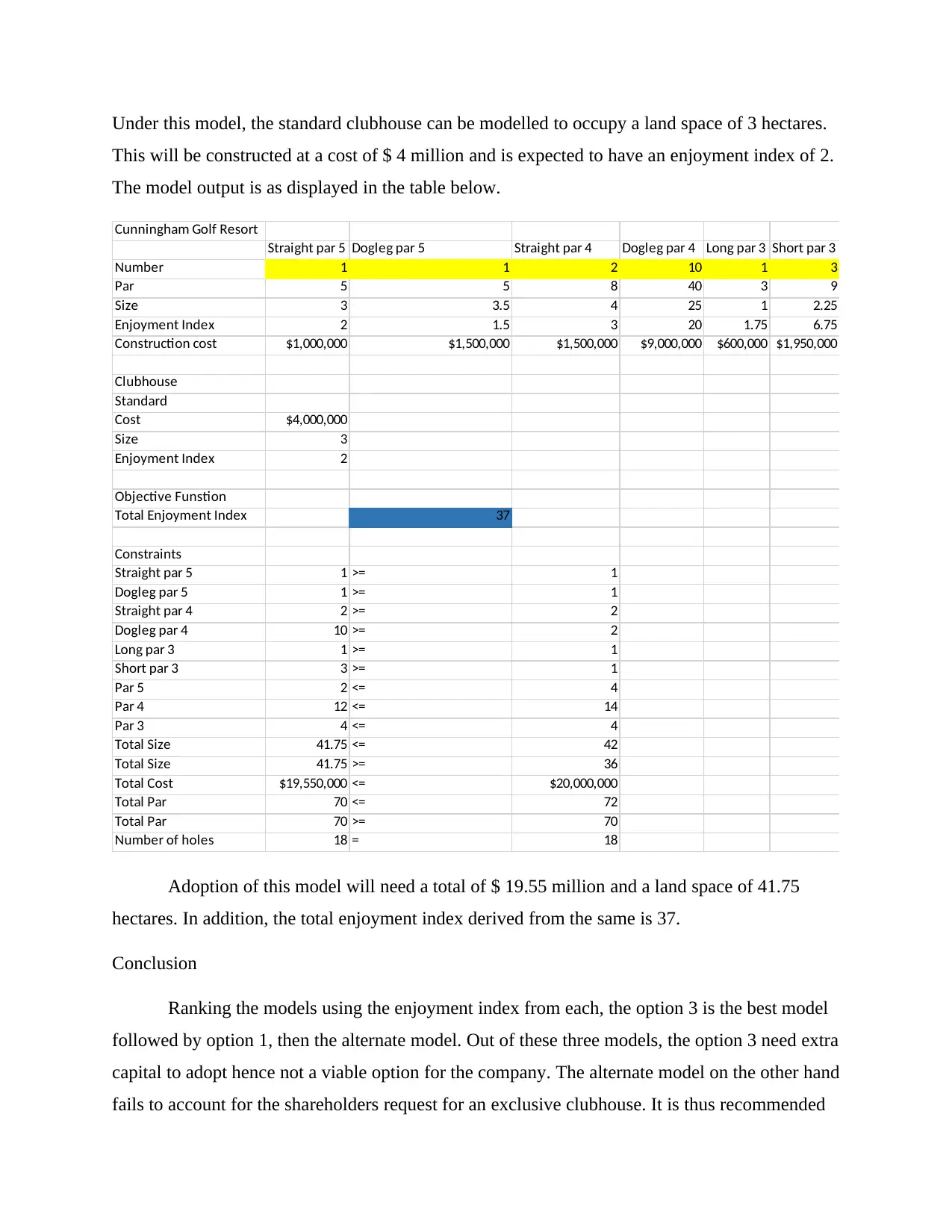
Under this model, the standard clubhouse can be modelled to occupy a land space of 3 hectares.
This will be constructed at a cost of $ 4 million and is expected to have an enjoyment index of 2.
The model output is as displayed in the table below.
Cunningham Golf Resort
Straight par 5 Dogleg par 5 Straight par 4 Dogleg par 4 Long par 3 Short par 3
Number 1 1 2 10 1 3
Par 5 5 8 40 3 9
Size 3 3.5 4 25 1 2.25
Enjoyment Index 2 1.5 3 20 1.75 6.75
Construction cost $1,000,000 $1,500,000 $1,500,000 $9,000,000 $600,000 $1,950,000
Clubhouse
Standard
Cost $4,000,000
Size 3
Enjoyment Index 2
Objective Funstion
Total Enjoyment Index 37
Constraints
Straight par 5 1 >= 1
Dogleg par 5 1 >= 1
Straight par 4 2 >= 2
Dogleg par 4 10 >= 2
Long par 3 1 >= 1
Short par 3 3 >= 1
Par 5 2 <= 4
Par 4 12 <= 14
Par 3 4 <= 4
Total Size 41.75 <= 42
Total Size 41.75 >= 36
Total Cost $19,550,000 <= $20,000,000
Total Par 70 <= 72
Total Par 70 >= 70
Number of holes 18 = 18
Adoption of this model will need a total of $ 19.55 million and a land space of 41.75
hectares. In addition, the total enjoyment index derived from the same is 37.
Conclusion
Ranking the models using the enjoyment index from each, the option 3 is the best model
followed by option 1, then the alternate model. Out of these three models, the option 3 need extra
capital to adopt hence not a viable option for the company. The alternate model on the other hand
fails to account for the shareholders request for an exclusive clubhouse. It is thus recommended
This will be constructed at a cost of $ 4 million and is expected to have an enjoyment index of 2.
The model output is as displayed in the table below.
Cunningham Golf Resort
Straight par 5 Dogleg par 5 Straight par 4 Dogleg par 4 Long par 3 Short par 3
Number 1 1 2 10 1 3
Par 5 5 8 40 3 9
Size 3 3.5 4 25 1 2.25
Enjoyment Index 2 1.5 3 20 1.75 6.75
Construction cost $1,000,000 $1,500,000 $1,500,000 $9,000,000 $600,000 $1,950,000
Clubhouse
Standard
Cost $4,000,000
Size 3
Enjoyment Index 2
Objective Funstion
Total Enjoyment Index 37
Constraints
Straight par 5 1 >= 1
Dogleg par 5 1 >= 1
Straight par 4 2 >= 2
Dogleg par 4 10 >= 2
Long par 3 1 >= 1
Short par 3 3 >= 1
Par 5 2 <= 4
Par 4 12 <= 14
Par 3 4 <= 4
Total Size 41.75 <= 42
Total Size 41.75 >= 36
Total Cost $19,550,000 <= $20,000,000
Total Par 70 <= 72
Total Par 70 >= 70
Number of holes 18 = 18
Adoption of this model will need a total of $ 19.55 million and a land space of 41.75
hectares. In addition, the total enjoyment index derived from the same is 37.
Conclusion
Ranking the models using the enjoyment index from each, the option 3 is the best model
followed by option 1, then the alternate model. Out of these three models, the option 3 need extra
capital to adopt hence not a viable option for the company. The alternate model on the other hand
fails to account for the shareholders request for an exclusive clubhouse. It is thus recommended
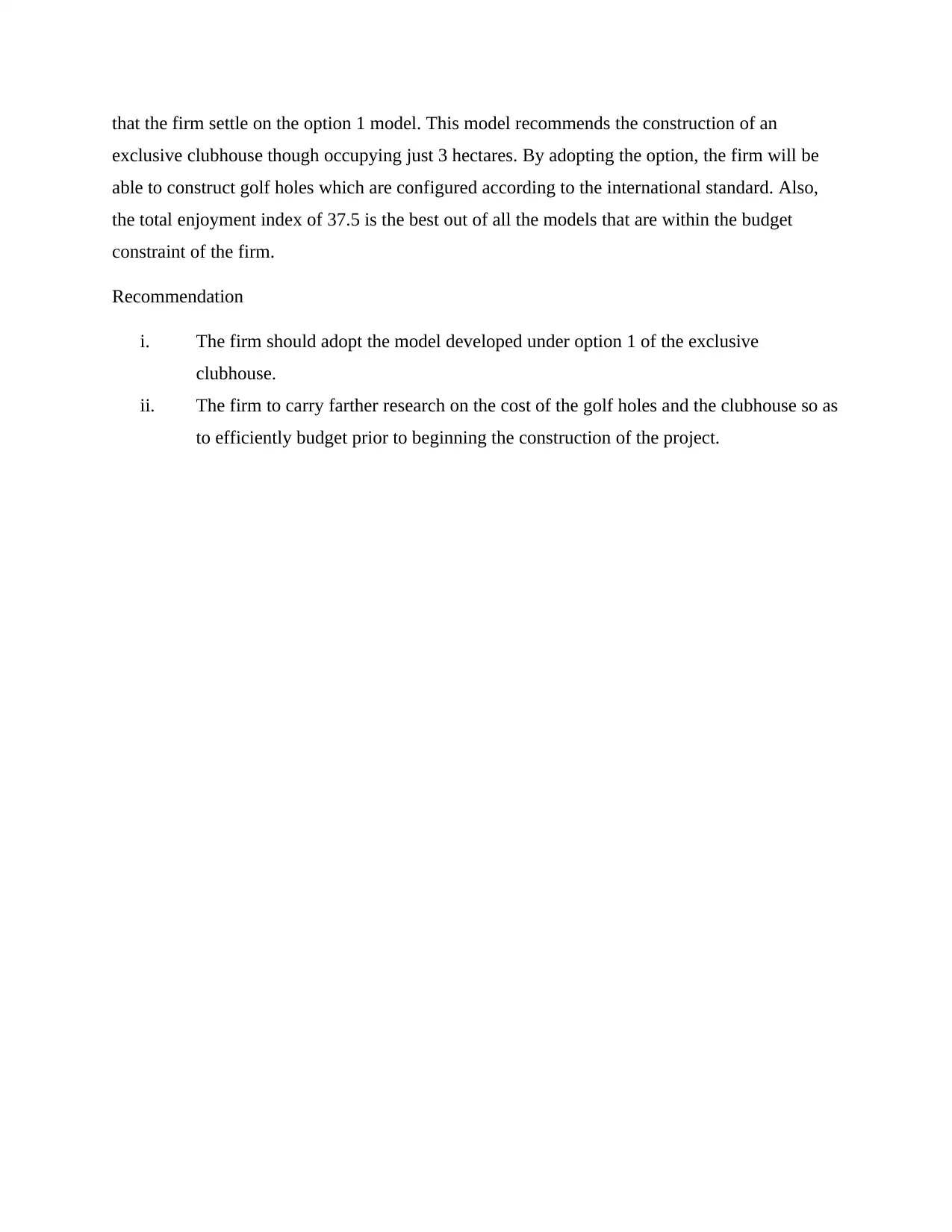
that the firm settle on the option 1 model. This model recommends the construction of an
exclusive clubhouse though occupying just 3 hectares. By adopting the option, the firm will be
able to construct golf holes which are configured according to the international standard. Also,
the total enjoyment index of 37.5 is the best out of all the models that are within the budget
constraint of the firm.
Recommendation
i. The firm should adopt the model developed under option 1 of the exclusive
clubhouse.
ii. The firm to carry farther research on the cost of the golf holes and the clubhouse so as
to efficiently budget prior to beginning the construction of the project.
exclusive clubhouse though occupying just 3 hectares. By adopting the option, the firm will be
able to construct golf holes which are configured according to the international standard. Also,
the total enjoyment index of 37.5 is the best out of all the models that are within the budget
constraint of the firm.
Recommendation
i. The firm should adopt the model developed under option 1 of the exclusive
clubhouse.
ii. The firm to carry farther research on the cost of the golf holes and the clubhouse so as
to efficiently budget prior to beginning the construction of the project.
⊘ This is a preview!⊘
Do you want full access?
Subscribe today to unlock all pages.

Trusted by 1+ million students worldwide
1 out of 13
Related Documents
Your All-in-One AI-Powered Toolkit for Academic Success.
+13062052269
info@desklib.com
Available 24*7 on WhatsApp / Email
![[object Object]](/_next/static/media/star-bottom.7253800d.svg)
Unlock your academic potential
Copyright © 2020–2025 A2Z Services. All Rights Reserved. Developed and managed by ZUCOL.





